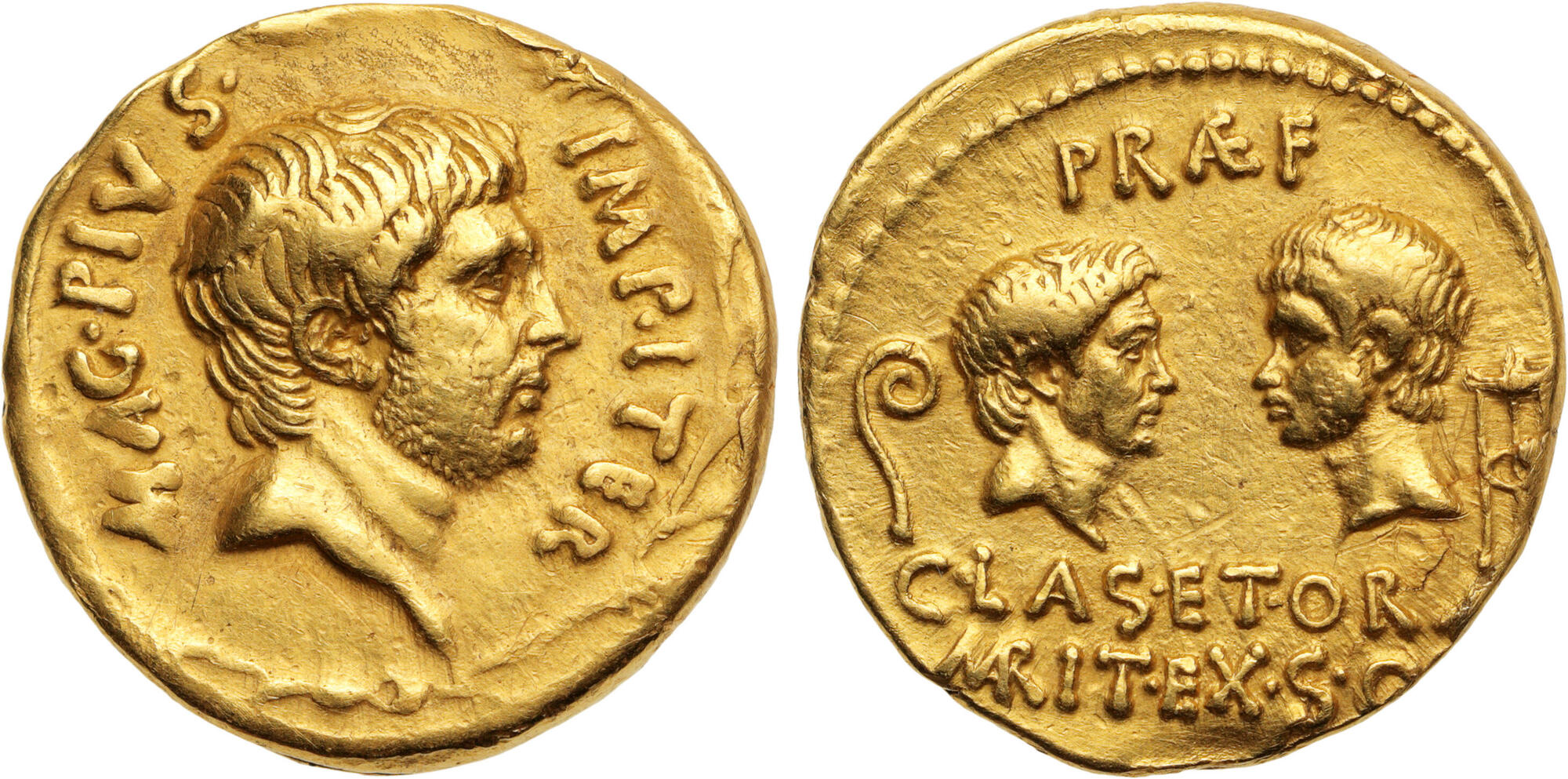Sicily (uncertain mint), gold, aurei (RRC 511/1 Sextus Pompeius - 42-40 BCE)
From SILVER
36 BCE - 36 BCE Gold 3,198 kg
Description
| ObverseInscription or printing placed on the obverse.: | MAG·PIVS IMP·ITER (Latin).Head of Sextus Pompey, right, bearded. Oak-wreath as border. |
| ReverseInscription or printing placed on the reverse.: | PRA͡EF CLAS·ET·ORA͡E / M͡A͡RIT·EX·S·C (Latin).Heads of Pompey the Great and Pompey the Younger facing each other, the latter bearded, on left, lituus, on right, tripod . Border of dots. |
Mint and issuing power
| MintIdentifies the place of manufacture or issue of a numismatic object.: | Sicily (uncertain mint) | Ancient regionAncient region.: | Sicily | Modern countryModern country: Italy | AuthorityIdentifies the issuing power. The authority can be "pretended" when the name or the portrait of X is on the coin but he/she was not the issuing power. It can also be "uncertain" when there is no mention of X on the coin but he/she was the issuing power according to the historical sources: | Roman Republic |
Chronology
| FromIdentifies the initial date in a range assigned in a numismatic context. | 36 BCE | toIdentifies the final date in a range assigned in a numismatic context.. | 36 BCE | PeriodTime period of the numismatic object.: Roman from 30 BC |
Physical description
| MetalThe physical material (usually metal) from which an object is made.: | Gold |
Median weightMedian of the weights of numismatic objects (in grams). in grams | 8.2 | DenominationTerm indicating the value of a numismatic object. Examples: tetradrachm, chalkous, denarius.: | aureus | StandardStandard.: |
Image

Aureus_511_1.jpg [1]
References
| Die study referencePublication of the study: | DeRose Evans 19871DeRose Evans 1987, p.129-131 | ||
| Coin series referenceReference to coin series study: | RRC 511/12RRC 511/1 | ||
| Coin series web referenceCoin series web references: | |||
Obverse dies distribution
| FrequencyFrequency of specimen in distribution. ᵖ | Number of obversesNumber of obverse dies. ᵖ (o) | % (o) | Number of coinsNumber of coins. (n) | % (n) | Die nameName(s) of the die(s). |
| 9 | 1 | 50 | 9 | 23.68 | 2 |
| 29 | 1 | 50 | 29 | 76.32 | 1 |
| Total | 2 of 2 | 100 | 38 of 38 | 100 |
Reverse dies distribution
no distribution is available
Quantification
| Number of obversesNumber of obverse dies. ᵖ (o) | 2 | Number of singletons (o1)The number of singleton coins. ᵖ | |
| Number of reverse diesNumber of reverse dies. (r) | 3 | Number of coinsNumber of coins. (n) | 38 |
| Coins per obverse dieNumber of coins per obverse die. (n/o) | 19 | Coins per reverse dieNumber of coins per reverse die. (n/r) | 12.67 |
| Reverse per obverse ratioRatio of obverse dies divided by reverse dies. (r/o) | 1.5 | Percentage of singletons (o1)number of coins (n) divided by the number of singletons (o1) ᵖ | % |
| Original number of dies (O) (Carter 1983 formula)The estimation of the number of coins according to Carter 1983 ᵖ | 1.95 | Coins struck if 20,000 as average productivity per dieCoins made if the average productivity for obverses (according to Carter) is 20,000. ᵖ | 39,000 |
| Original number of dies (O) (Esty 2011 formula)The estimation of the number of coins according to the singleton formula in Esty 2011 ᵖ (O) | 2.11 | Survival rate if 20,000 as average productivity per dieSurvival rate if average productivity is 20,000. ᵖ | 0.00097 |
| Coverage (o = % of O) (Esty 1984 formula)Esty 1984 - coverage (% of O) ᵖ (o = % of O) | % | Die productivity if survival rate 1/2,000Average productivity if survival rate is 1/2,000. ᵖ | 38,974.36 |
| Weight of silver (in kg) if 20,000 coins per die (O = Carter formula)Carter 1983 * Median weight * 20000 (*10 if gold or electrum) ᵖ | 3,198 kg <br /> 3,198 kg | Die productivity if survival rate 1/5,000Average productivity if survival rate is 1/5,000. ᵖ | 97,435.9 |
Remarks
Most likely one single workstation Certainly military